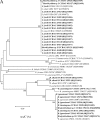Biodiversity and biogeography of rhizobia associated with soybean plants grown in the North China Plain
- PMID: 21784912
- PMCID: PMC3187167
- DOI: 10.1128/AEM.00542-11
Biodiversity and biogeography of rhizobia associated with soybean plants grown in the North China Plain
Abstract
As the putative center of origin for soybean and the second largest region of soybean production in China, the North China Plain covers temperate and subtropical regions with diverse soil characteristics. However, the soybean rhizobia in this plain have not been sufficiently studied. To investigate the biodiversity and biogeography of soybean rhizobia in this plain, a total of 309 isolates of symbiotic bacteria from the soybean nodules collected from 16 sampling sites were studied by molecular characterization. These isolates were classified into 10 genospecies belonging to the genera Sinorhizobium and Bradyrhizobium, including four novel groups, with S. fredii (68.28%) as the dominant group. The phylogeny of symbiotic genes nodC and nifH defined four lineages among the isolates associated with Sinorhizobium fredii, Bradyrhizobium elkanii, B. japonicum, and B. yuanmingense, demonstrating the different origins of symbiotic genes and their coevolution with the chromosome. The possible lateral transfer of symbiotic genes was detected in several cases. The association between soil factors (available N, P, and K and pH) and the distribution of genospecies suggest clear biogeographic patterns: Sinorhizobium spp. were superdominant in sampling sites with alkaline-saline soils, while Bradyrhizobium spp. were more abundant in neutral soils. This study clarified the biodiversity and biogeography of soybean rhizobia in the North China Plain.
Figures







References
-
- AFNOR 2005. Soil quality, determination of pH. NF ISO 10390. AFNOR, Paris, France
-
- Appunu C., Sasirekha N., Prabavathy V. R., Nair S. 2009. A significant proportion of indigenous rhizobia from India associated with soybean (Glycine max L.) distinctly belong to Bradyrhizobium and Ensifer genera. Biol. Fert. Soils 46:57–63
-
- Camacho M., et al. 2002. Soils of the Chinese Hubei province show a very high diversity of Sinorhizobium fredii strains. Syst. Appl. Microbiol. 25:592–602 - PubMed
-
- Chen W. L., Huang Q. Y., Xiong X. J. 2004. Distribution and biodiversity of soybean rhizobia in the soils of Shennongjia forest reserve, China. Biol. Fert. Soils 40:306–312
Publication types
MeSH terms
Substances
Associated data
- Actions
- Actions
- Actions
- Actions
- Actions
- Actions
- Actions
- Actions
- Actions
- Actions
- Actions
- Actions
- Actions
- Actions
- Actions
- Actions
- Actions
- Actions
- Actions
- Actions
- Actions
- Actions
- Actions
- Actions
- Actions
- Actions
- Actions
- Actions
- Actions
- Actions
- Actions
- Actions
- Actions
- Actions
- Actions
- Actions
- Actions
- Actions
- Actions
- Actions
- Actions
- Actions
- Actions
- Actions
- Actions
- Actions
- Actions
- Actions
- Actions
- Actions
- Actions
- Actions
- Actions
- Actions
- Actions
- Actions
- Actions
- Actions
- Actions
- Actions
- Actions
- Actions
- Actions
- Actions
- Actions
- Actions
- Actions
- Actions
- Actions
- Actions
- Actions
- Actions
- Actions
- Actions
- Actions
- Actions
- Actions
- Actions
- Actions
- Actions
- Actions
- Actions
- Actions
- Actions
- Actions
- Actions
- Actions
- Actions
- Actions
- Actions
- Actions
- Actions
- Actions
- Actions
- Actions
- Actions
- Actions
- Actions
- Actions
- Actions
- Actions
- Actions
- Actions
- Actions
- Actions
- Actions
- Actions
- Actions
- Actions
- Actions
- Actions
- Actions
- Actions
- Actions
- Actions
- Actions
- Actions
- Actions
- Actions
- Actions
- Actions
- Actions
- Actions
- Actions
- Actions
- Actions
- Actions
- Actions
- Actions
- Actions
- Actions
- Actions
- Actions
- Actions
- Actions
- Actions
- Actions
- Actions
- Actions
- Actions
- Actions
- Actions
- Actions
- Actions
- Actions
- Actions
- Actions
- Actions
- Actions
- Actions
- Actions
- Actions
- Actions
- Actions
- Actions
- Actions
- Actions
- Actions
- Actions
- Actions
- Actions
- Actions
- Actions
- Actions
- Actions
- Actions
- Actions
- Actions
- Actions
- Actions
- Actions
- Actions
- Actions
- Actions
- Actions
- Actions
- Actions
- Actions
- Actions
- Actions
- Actions
- Actions
- Actions
- Actions
- Actions
- Actions
- Actions
- Actions
- Actions
- Actions
- Actions
- Actions
- Actions
- Actions
- Actions
- Actions
- Actions
- Actions
- Actions
- Actions
- Actions
- Actions
- Actions
- Actions
- Actions
- Actions
- Actions
- Actions
- Actions
- Actions
- Actions
- Actions
- Actions
- Actions
- Actions
- Actions
- Actions
- Actions
- Actions
- Actions
- Actions
- Actions
- Actions
- Actions
- Actions
- Actions
- Actions
- Actions
- Actions
- Actions
- Actions
- Actions
- Actions
- Actions
- Actions
- Actions
- Actions
- Actions
- Actions
- Actions
- Actions
- Actions
- Actions
- Actions
- Actions
- Actions
- Actions
- Actions
- Actions
- Actions
- Actions
- Actions
- Actions
- Actions
- Actions
- Actions
- Actions
- Actions
- Actions
- Actions
- Actions
LinkOut - more resources
Full Text Sources
Molecular Biology Databases
Research Materials
Miscellaneous

